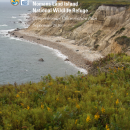What We Do
Wildlife conservation is at the heart of the National Wildlife Refuge System. It drives everything on U.S. Fish and Wildlife Service lands and waters managed within the Refuge System, from the purposes for which a national wildlife refuge national wildlife refuge
A national wildlife refuge is typically a contiguous area of land and water managed by the U.S. Fish and Wildlife Service for the conservation and, where appropriate, restoration of fish, wildlife and plant resources and their habitats for the benefit of present and future generations of Americans.
Learn more about national wildlife refuge is established to the recreational activities offered to the resource management tools used. Using conservation best practices, the Refuge System manages Service lands and waters to help ensure the survival of native wildlife species.
Management and Conservation
Refuges deploy a host of scientifically sound management tools to address biological challenges. These tools span active water management to wilderness character monitoring, all aimed at ensuring a balanced conservation approach to benefit both wildlife and people. At this field station our conservation tool box includes:
Planning – Comprehensive Conservation Plan
Species Research
Fire Management
At least 14 species of invasive plants have been identified on Nomans Land Island National Wildlife Refuge. The unchecked spread of invasive plants threatens the biological diversity, integrity and environmental health of all national wildlife refuge national wildlife refuge
A national wildlife refuge is typically a contiguous area of land and water managed by the U.S. Fish and Wildlife Service for the conservation and, where appropriate, restoration of fish, wildlife and plant resources and their habitats for the benefit of present and future generations of Americans.
Learn more about national wildlife refuge habitats. In many cases, they have a competitive advantage over native plants and form dominant cover types, reducing the availability of native plants as food and cover for wildlife. Over the past several decades, government agencies, conservation organizations, and the public have become more acutely aware of the negative effects of invasive species invasive species
An invasive species is any plant or animal that has spread or been introduced into a new area where they are, or could, cause harm to the environment, economy, or human, animal, or plant health. Their unwelcome presence can destroy ecosystems and cost millions of dollars.
Learn more about invasive species .
Prescribed fire is utilized to achieve habitat management goals; however, instead of burning on a set periodic schedule, we burn only as habitat conditions warrant based on vegetation monitoring. Wind and salt spray can considerably delay succession in maritime habitats, and it is not known how long quality refuge shrubland habitat will persist without fire management and still provide a benefit to species of concern.
Our Projects and Research
Most research, projects, and initiatives on the refuges comprising the Eastern Massachusetts National Wildlife Refuge Complex examine management of avian resources, various public uses, rare, threatened, or endangered species and habitats, and invasive species invasive species
An invasive species is any plant or animal that has spread or been introduced into a new area where they are, or could, cause harm to the environment, economy, or human, animal, or plant health. Their unwelcome presence can destroy ecosystems and cost millions of dollars.
Learn more about invasive species control. In 2019, New England cottontails were released on the refuge to establish a new population.
Law Enforcement
Eastern Massachusetts National Wildlife Refuge Complex law enforcement is designed to protect wildlife and habitat through state and federal laws.
Laws and Regulations
Various laws and regulations define the authority and responsibility for the Fish and Wildlife Service to conserve and preserve species, and habitats on federal land.

